Tuesday, October 25, 2011
It's back to work at the museum today! Play time is over. There is a web site to build! I have spend this week, Tuesday through Friday in meetings discussing the new NEQM web site and researching technology for building it. I seriously considered Drupal because it offers so much flexibility and that type of modular approach is the wave of the future. But Drupal is pretty intense and the learning curve is pretty big. I would need someone to help me, and/or some training materials that would have to be purchased. The museum has no budget for that.
I looked at some other web builders, which quite frankly are everywhere -- all over the net. Some of them look pretty good, but they all seem to require that you host with the company offering the web builder. I don't think it's wise to get locked into a hosting company. Things change, and we can't predict what the museum's web needs will be in two or three years. I don't want them to be in a position where they are forced into making changes they may not want to make.
 Finally, I think I have found something that will work well. Joomla! is similar to Drupal, but not as high level. It requires no coding knowledge, although you can alter the code for certain effects if you know how. The web has an abundance of teaching tools and videos that are all free. I have a host that caters to Joomla! and will give support for Joomla! sites in addition to the support they offer for hosting. I have watched some videos and started building a test site to see how the system works. I like the idea of being able to add extensions and endless functionality. I think it will help the museum keep their site fresh as time goes along.
I am also helping the museum librarian, Martha Supnik, find software that will allow their book database to be searched on-line from the web site. This library has many thousands of books. They lend to museum members. They also have a perpetual yard sale. Any books donated to the library that are duplicates are for sale for $5 or $10. So far, we are still in the software learn and search mode. Martha has found a library package she thinks she might like, but isn't sure. She would like to test it out before committing. I found that the Guggenheim Museum uses both Joomla! and the library software she likes. Maybe that will help her decide. I was really hoping she would like a Joomla! extension that was designed for a library search. Unfortunately, she really didn't care for it, although I thought it had all the function she needs.
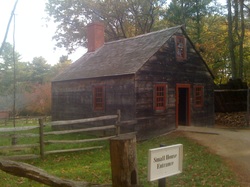 Monday, October 24, 2011
Old Sturbridge Village is a living history museum that portrays life in New England during the 1830s. All the structures are authentic, but have been moved to the site to emulate a village from the time period. There are many businesses including a tavern, a tin shop, a law office, a printing office, etc. We especially enjoyed the Fenno House which depicted the life of a widow and her daughter who engaged in spinning and weaving. Raw cotton, wool, flax, and silk fibers were on display in the house, and wool carding brushes were available so visitors could try their hand at it. The widow was there spinning with her loom nearby. Upstairs were two bed chambers with quilts, a sewing table, and some furnishings and costumes from the period. There were several exhibits housed in period buildings. The ones we really enjoyed were the glass exhibit and the textiles exhibit (of course!). The textile exhibit had examples of hand looms, and power looms. The museum put a great emphasis on how the spinning and weaving technology that developed during the late 17th and early 18th centuries impacted the lifestyles of New Englanders. Less and less spinning and weaving was occurring in homes. Technology to improve farming techniques decreased the amount of time required to raise crops. Transportation became faster, and more available. Fewer farms gave way to urban life where factory and trade work was available. By 1840, more than 670 cotton factories were operating in New England. Fewer and fewer people were purchasing cloth rather than weaving it in their homes. The economy was transformed and the textile industry became the most important industry in New England for the next 150 years. The textile exhibit had examples of hand and power looms, exhibits that featured recipes for dying cloth, and samples of drafts (patterns) and weaving patterns that survived from the 19th Century. These patterns were for overshot bed coverlets and diaper cloth for tablecloths and dishtowels. The patterns had all the information to set up the loom and how to weave the pattern. These patterns were recorded by a mother and daughter from Dartmouth, Massachusetts.
We toured the Salem Towne House, built in 1796 and moved to Old Sturbridge Village in 1952. I was surprised by how nice it was. There was lots and lots of wallpaper! There was a carpet in the front parlor. The pattern was a repeated block and looked like quilt squares to me. In the center hall and dining room there was canvas on the floor that had been painted to look like carpet. Interesting to see that. The guide said the home would have belonged to an upper middle class family. It was very, very nice. There were quilts on the beds up stairs, but we couldn't get close enough to see them very well.
 Sunday, October 23, 2011This morning we left early, our sites set on New York once again. So off we went, this time driving into the city from the south. Oh what a view! Since it was Sunday, the traffic was light and we even found parking -- and not illegal parking like last week :) We went to the 9/11 Memorial first. We weren't able to get tickets ahead of time, and those for the day were already gone, so we didn't go on a tour. We had to be satisfied with what we could see. There is covered fencing up all around area, and you couldn't see in at all. This was much different than four years ago when I was visiting New York with Mozelle. At that time, you could look through the fence and see everything that was going on. A woman at the memorial office suggested we go to the Winter Garden at the World Financial Center. We did that and found quite a view. Some of the towers that are being rebuilt are well underway and that progress was good to see. The new Tower One, nicknamed The Freedom Tower will be 1776 feet tall when it's finished. We then found our way to 8th and 66th street, just a block from Central Park. During lunch at a sidewalk cafe in Lincoln Square we had a great time people watching. Since it was Sunday late morning, many families were coming/going to church. In their fancy dresses, all the little girls were adorable; then there were the toddlers who wailed because they wanted to be carried, or the reverse, they wanted to walk; the most impressive of all was the woman in the five inch leopard-print heels had to take the cake. How could she walk anywhere in those? OUCH! Right next door was the American Folk Art Museum. They had a great quilt exhibition up called Super Stars: Quilts from the American Folk Art Museum. Also, the 9/11 National Tribute Quilt was on display. Tomorrow is Monday and the NEQM is closed. So, what's on the agenda for Pam and I? Well, since we have to go by Old Sturbridge Village we will stop there tonight and visit there in the morning!
 Saturday, October 22, 2011
On the way to Winterthur yesterday and today we drove through a beautiful covered bridge. The days here have been sunshine and crisp, just perfect fall weather. Today's lectures were equally as interesting as those from yesterday, topped off by a fascinating presentation by Dr. Lynn Hulse former archivist at the Royal School of Needlework. In the afternoon we attended two workshops: The first was an opportunity to look at many of the rare books, patterns, scrapbooks, and other ephemera in the Winterthur libraries. I really enjoyed looking at these! We also went on a tour of the needlework in the Winterthur collection located on the fifth and sixth floors of the mansion. What lovely samplers and quilts we saw! Sadly, it was the end of this wonderful adventure.
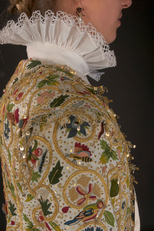 Friday, October 21, 2011 Today we arrived at Winterthur, the home Henry Du Pont lived in and later made into a museum. The conference was held at their visitor center and was everything I hoped it would be and more! The first lecture was given by Tricia Wilson who was a key person in the Plimoth Jacket Project. She explained how the project was conceived, planned, and carried out. The project resulted in a reproduction of a 17th Century embroidered jacket. All work was carried out by hand just as it was when the original was made. Jill Hall, co-manager of the project gave a fascinating talk about clothing in the 17th Century and the use of decorative gold thread and spangles. She said that at that time there was no currency and so clothing was often like a "bank" to the owner. These gold laden clothes could be pawned for their gold. When they were no longer wanted, there was an active resale market where clothes were often burned in order to recoup the gold. Other lectures focused on needlework samplers and the training young girls received in stitching.
 1787 Rachel Mackey Quilt embroidered medallion 1787 Rachel Mackey Quilt embroidered medallion After eating a scrumptious lunch, Pam and I took a tour of the grounds which included a 60 acre garden planned by Mr. Du Pont as well as the Enchanted Woods, a garden for children. Afterward, we went to the house museum and took a tour of the third floor. We spent the remainder of the afternoon enjoying the exhibitions. The With Cunning Needle: Four Centuries of Embroidery exhibition of course related to the conference and is where the Plimoth Jacket was displayed. In one of the galleries we saw a beautiful 18th Century quilt with an embroidered center medallion. It is an extraordinary piece that is in very good condition. It was exciting to see this as one of my particular interests is quilts with embroidery. I wonder if some of the motifs seen in samplers and other embroidered pieces can be found in embroidered quilts of the same time?
 Times Square New York City Thursday, October 20, 2011 New York City is always a hustle bustle place and today was no different. We drove into the city and luckily finally found a place to park that wasn't too far from the Metropolitan Museum of Art, our first destination. It was a beautiful day and we saw everything from the Naked Cowboy singing in Times Square to a police officer on horseback to various musicians playing on the street corners. In fact, there was a group that was singing in front of the Met.
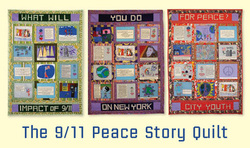 Faith Ringgold's 9/11 Peace Story Quilt was the first place we went. This "story" quilt was three panels hung side by side. It was designed in collaboration with New York City students. Reactions to the events of 9/11 are recorded in the words and images from children ages eight through nineteen. The overall message is one of hope and peace with a united world. The exhibition Arts of Korea/Patchwork Textiles was our next destination. These pieces, some contemporary, were beautiful and fascinating. The stitches were tiny, tiny, and the motifs beautifully executed. Although the name of the exhibition leads you to believe the objects will all be Korean, it also includes textiles from China, and Peru. An Amish quilt from the United States was included to illustrate its similarity to some of the Korean pieces. The interesting question is: how did these both develop in cultures that were not connected? Unfortunately for us, we didn't have nearly enough time to spend at the Met. However, just being in the building is exciting and intriguing. It is so grand, so busy, so varied in its many offerings. Everywhere you turn is something else more fascinating than the last. When we walked from the Ringgold exhibit to the Korean textile exhibit, we literally went from one end of the museum to the other. In between we went through the ancient near eastern art, the Asian, (last time I was at the Met I hung out there LOVE IT!), and Egyptian galleries. It was absolute torture to have only a few short moments here and there to stop and enjoy these objects. It was all about the parking! We had a parking place on the street about six blocks away. God forbid, we didn't want a ticket! We could have parked in the Met's garage, but thought $15 per hour was outrageous. However, we saw other garages later in the day with rates up to $30 - yes, that is for each and every hour that they mind your auto! That makes my head spin!
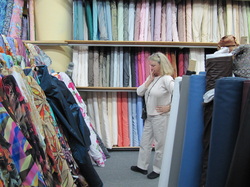 Next stop: the garment district. Pam is participating in a civil war reenactment and must find some silk to make a period dress. So she simply had to drag me down to 39th street! What a terrible terrible fate :) Fortunately the parking was not nearly so difficult there. We found lots of parking places in a commercial zone, so we simply parked illegally and just kept an eye on the car in between shops! We had a grand time and Pam found her silk. I was drooling the entire time, of course. I haven't sewn clothes in many, many years, but these glorious fabrics are wonderful inspiration to begin again! Go see a few photos of these fabrics, and lovely trims -- yes, we went to a shop that carried only trims, buttons, and other specialty notions. !!!!
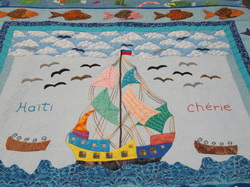 Haiti Cherie Art Quilt Wednesday, October 19, 2011
This morning was spent double checking the quilts packed to be returned to their owners and moving the boxes and other quilts packed in bags and pillowcases downstairs to the shop vault for safe keeping. That sounds pretty simple, but what a haul! Our shop vault does not have much extra space, and a few of these boxes are really LARGE! I am talking about the quilts that were loaned to us by museums. The quilts were packed in archival boxes and then in shipping boxes. They weren't very heavy, but very awkward indeed.
Then I spent some time with Maureen Smith, the public relations director for NEQM. I introduced her to Web building technology that I think is the best way to go for the time being for their web site. There are many different "brands" of Web building technology, but in the end most of it is just drag and drop to create a site with text, images, and slide shows. It would be really nice if they could have an entire site rebuild by a professional Web designer assisted by a graphic designer. That isn't going to happen in the immediate future, but I have made the suggestion. Perhaps grant money might be the way to get that done. I have also suggested they forge a partnership with the University of Massachusetts in Lowell and see if they can get a couple of interns that specialize in software development/Web design and graphics. That would be very helpful.
This afternoon the curator, Paw Weeks, and I left for our trip to Winterthur, Delaware, where we are going to a needlework conference. Our goal was to drive a few hours out of town towards New York so we could get a jump on our driving. Tomorrow we are headed to New York for the day!
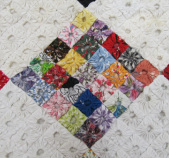 Yo Yo Quilt from the Maine Exhibit Today was spent finishing up condition reports and packing the remaining quilts from the Maine exhibition. The good news is that it's all done. It was nice today to have a museum volunteer to help me with the turning and folding. Thank you Betty! It takes a lot longer to do it by yourself when you are working with quilts that are very fragile like the ones today. We did have one crazy quilt to send back that was just BEAUtiful! It was in almost perfect condition, which doesn't often happen with crazy quilts. They usually have silks in them that have deteriorated with age. There is one quilt we need to track down the box for and one more little doll quilt that I think was sent with someone else's quilt. I need to find out who. Then the paperwork needs to be generated and the boxes shipped. Almost there!
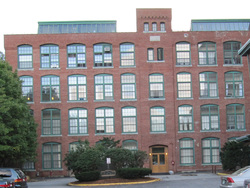 This is where I live. Canal Place is an old mill built in 1909 Monday, October 17, 2011
Now that all the Maine quilts are down, they must have condition reports completed, and be folded and repacked in their original shipping boxes or other containers. That is primarily what I worked on today. It was quite time consuming and I didn't get finished although I worked on it all day long. It's fun to be this close to all these beautiful historical quilts. It's not fun to do the folding, packing, and paperwork. But, it all goes with the territory and proper care of these wonderful treasures is really important. While I was doing that today, we had five or six great volunteers that came in to help hang the new quilts. Some rearranging had to be done to accomplish that, and it all got finished. The quilts are all up, and tomorrow the labels and some art work that arrived with the exhibition need to be placed throughout the gallery.
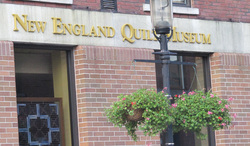 Sunday, October 16, 2011
This morning came too early to say the least. We drove the hour from Pam's house to the NEQM to begin taking down the Maine's Quilt Heritage exhibition, and preparing to install the next exhibition, Patience to Raise the Sun: Art Quilts from Haiti & Their Power to Change Women's Lives. Another intern, Kate, came in today and we finished unpacking the quilts for the new exhibition and did all the condition reports. Quite a job! It was great to have Kate here. It goes much quicker with two people, two pairs of hands, and two sets of eyes. Kate is currently working at the Kennedy Museum in Boston, and has worked at the National American History Museum in Washington D.C. She has a lot of training in museum and collection procedures so she is a good instructor for me. Kate will be working at the NEQM on Saturdays.
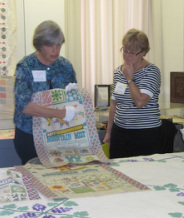 Marikay showing Mountain Mist patterns Saturday, October 15, 2011
Today was the symposium. Everything went very well. I functioned as NEQM staff and as a participant. We had an opening address from Madelyn Shaw, and then rotations to the other speakers began. I spent the first two rotations at the NEQM in the quilt turning with Marikay. She brought with her many original patterns from newspapers, magazines, and Mountain Mist wrappers. We had several quilts that were either exactly the pattern she brought, or almost exactly the same. One great example is a Ruby Short McKim pattern of The Three Little Pigs. It was an embroidery pattern that had a series of blocks. One block was published in the newspaper each week. We had a quilt in the NEQM collection that followed her pattern exactly. Pretty Cool!! Marikay has a fabulous collection of historical patterns and articles. One great source has been the patterns collected for thirty years by Mildred Dickerson, Marikay stumbled upon this collection one day unexpectedly and purchased it. OHH what a find! Thank you Mildred for doing what Marikay advises us all to do: KEEP THE PAPER! I promise Marikay I will do better!
At lunch time the symposium moved to the American Textile History Museum where there is a cafe and a yummy buffet lunch. Before the next session began, I had a chance to poke around the museum a little bit -- very cool! I will have to go back. They had an exhibit called Grace and Glamor: 1930's Fashions. It was fabulous! Then I watched a video about how baseballs are tested and torn apart to assure there is no tampering going on. It was pretty darn amazing! . The topic of the lecture given by Giles Kotcher was decorative arts and designers 1920 - 1940. He had a very interesting way of linking textiles to history. For example, in the 1930s nylon stockings were developed, replacing the very expensive silk stockings. 60% of Japan's economy was supported by their silk exports. 75% of the silk consumed by the U.S. was used for silk stockings. When nylons became available, the demand for silk plummeted, negatively impacting the Japanese economy. This "event" contributed to Japan's economic issues that ultimately led them to look for other economic resources. Japan invaded China to expand their economy which was their gateway into World War II. How's that for textiles impacting the world?
The symposium ended with a keynote address by Marikay Waldvogel. Her topic was the role of quilts during the 1930s which closely followed her book Soft Covers for Hard Times. She also had a great presentation about the Sears quilt contest at the 1933 Chicago World's Fair -- who won and why -- seems like a little hanky panky was going on. Burst my bubble! I thought all quilters were nice, like me! All in all, it was a terrific day of textiles and learning! Party Time! After our symposium guests left the museum, and things were put back together, Pam and I left for New Hampshire where we were invited to a party being thrown by one of her dearest friends, Katy. Oh my my! It was a gorgeous drive north and the party was fun fun fun. She had a beautiful home on acreage and on the river to boot. Too bad when we got there it was about dark, because I would love to see the grounds and the view! Pam took me up some (many) winding narrow stairs to the cupola that is windows all around. In the daytime, I can't even imagine the view. There is a bed up there in that tiny room, so on occasion someone gets to sleep up there. WOW! What great sleeping! At this party, I heard all sorts of New England "gossip" and the story about how another of Pam's friends ran Aristotle Onassis out of town in the early 70s when he tried to buy up land options in an attempt to put an oil refinery in Durham. Can you imagine? Dudley Dudley went on to have a political career. She was a heroine in the state of New Hampshire! She is also very down to earth and modest. When I was chatting with Dudley I asked her what she did and she described herself as "I have done a little of this, a little of that, a little politics." Later Pam told me about the Aristotle incident. Apparently even Jackie came to Durham. My goodness! What a terrific bash, complete with a great live band in the living room!
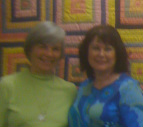 Marikay Waldvogel and Me! Today was a busy day at the NEQM. We are hosting a symposium with the American Textile History Museum tomorrow, Fabrics, Fashions, and Quilts: From the Armistice to Pearl Harbor. Collections Manager Laura Lane and I changed out some objects in the permanent gallery. We replaced quilts in the drawers of a dresser with fabrics, catalogs, and patterns from the 1930s. These drawers are covered with plexi-glass, so they serve as another type of display case. I learned a new word today: ephemera, which I thought referred to these miscellaneous objects. But when I looked it up, the dictionary says "items designed to be useful or important for only a short time, especially pamphlets, notices, tickets, etc." So I guess it might be used because we only have these objects out temporarily. We also brought about 15 or so period quilts upstairs from the collections vault and stacked them flat for a "quilt turning" tomorrow. Marikay Waldvogel, our keynote speaker, arrived in the early afternoon. We all worked together putting out the quilts and arranging some artifacts. We had fun looking through some recently donated scrapbooks of pamphlets, and newspaper and magazine articles and patterns dating back to the 1920s and 1930s. It was a treat to meet Marikay because she is a knowledgeable and respected authority in the field of historical quilts, patterns, designers, etc. She is a lecturer and has authored several scholarly articles and books. I have read some of her articles as part of my coursework. And wouldn't you know it, Mariy Kay is a Missouri girl just like me!
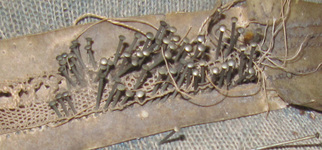 Ipswich bobbin lace This is bobbin lace that is in process. The "pins" or bobbins are put in place on a pillow and thread is worked in a pattern. You can see on the left side of the image the finished lace. As the lace is finished, the bobbins are removed and placed on the other end so the lace is continuous. I took this image today at Whipple House circa 1677 in Ipswich. Ipswich was known for its lace making which was done by hand in the home. It was a skill that was brought from England and passed from mother to daughter. In mid 18th Century, lace making became an industry and women could trade a cord of wood or sixteen pounds of sheep's wool for a yard of lace. It was in style and sought after by the wealthy. George Washington visited Ipswich to pay tribute to their lace making in 1789. He took some black lace home to Martha! By 1821, machinery to produce lace was imported from England. Now that it was machine made, lace became less luxurious and lost its social prestige now that it was available to almost everyone. While I was at Whipple House and Heard House circa 1800, I noticed a number of framed embroidered pieces. I was pleasantly surprised, and would like to know more about them.
You know what they say: when in Rome, do what the Romans do. So, of course I had to get some clams from Ipswich. I went to the Clam Box, a local spot. I knew it must be good because when I was here on Monday, there were people lined up out the door! So I found it again and got some advice from another customer on what to order. Since he was a local, he was familiar with all the clam joints in the area. He said this was the best and recommended fried clams. So I ordered that. They were good, but not great. I don't think I've ever had clams before. So, now I have!
While I was in Ipswich, I went to the library and did indeed find some information about Thomas Dorman. The book I found says he died in 1670 at the age of 70. John Dorman, my ancestor, had a brother, Thomas, who was born about 1600. They could be brothers. I wonder what else I can find out about Thomas. The records show he died in a town called Topsfield, a few miles away from Ipswich. There is a will. I wonder if I can see a copy of it and if it might give any more information about him, like where he was born? I will call the woman who works with the archives and see what she is willing to do. If there is a death certificate or will on file, maybe it will tell where he was born as well.
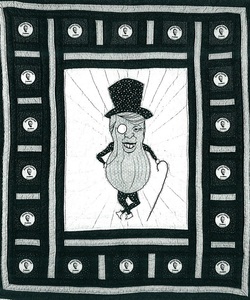 One of my favorite quilts called "Jimmy Who?" Today I met Maureen Smith, the marketing director for the museum. Next week we will spend some time together and come up with a plan for the Web site. I worked on more condition reports for the incoming quilts. I found a button was missing on one; thankfully we had an image of the quilt so I could see it was missing. I asked Pam if that needs to be reported to the owner of the quilt. I wonder if they know it's missing? Pam has had me document very carefully exactly which quilts are in each box. She wants to return them after the show in the same manner in which they were received. I spent a little bit of time with Laura, the collections manager today. As I unpacked the quilts for the exhibit and did condition reports, I put sheets between each quilt and stacked them on top of each other. When Laura saw them, she told me that they usually stack the quilts on top of one another without sheets in between, because they don't have enough sheets. I wonder if that is the customary practice in most museums? It seems that if a quilt was contaminated in any way (and you likely would not know that) it could cause a huge upset to expose it to other quilts. They don't have an isolation room, so there is no way to have any kind of control over the the things a quilt might bring into the museum. Humm??? Is that a problem, or am I over thinking this? I also continued working on my power point/catalogue adding information about the collection each quilt came from, maker, date, size. These issues may seem mundane, but important to know and hard to track down sometimes! The weather has turned cooler now and I'm afraid there will be no more days at the beach. But, now the leaves will really turn and reach their peak soon! I'd like to drive up to the Shelburne Museum in Vermont before they close at the end of the month. This weekend we are hosting a symposium on Saturday and we will be changing exhibits on Sunday, Monday, and Tuesday. The next weekend Pam and I will be in Winterthur at a needlework conference and the last weekend we will have our opening for Patience to Raise the Sun. I don't know where I will find the time but there must be a way!
 Patience to Raise the Sun Tuesday, October 11, 2011 I continued to work on my power point and searched for additional quilts for the C&C exhibition coming up. Pam and I began condition reports for incoming quilts for the Patience to Raise the Sun Exhibition that will be hung next week. Pam said she is in favor of clean hands instead of using gloves when handling the quilts. She said some museums are no longer using gloves because of they tend to pick up dirt which then can be transferred to other quilts. So into the vaults we went. The NEQM is located in an old bank building. There are two vaults complete with heavy steel doors. That's where the quilts are kept; one holds their permanent collection, the other holds quilts that are on loan and is used for a little bit of other storage. Frankly, there is a lot of junk in there and it could do with a good cleaning and reorganization -- let me at it! The vault housing the permanent quilt collection is much larger and although not in perfect order, it does have an organization system. All the quilts are in archival boxes and stored on labeled shelves. I suppose there is a list somewhere of what goes where. The BEST part is that all the boxes have an image attached to the outside so you know what's in that box! I noticed they have a lot of crazy quilts in their collection. I could see that just from walking through the vault. I think vaults must be fireproof, so these are a good place to protect them in case of fire or flood (?). The NEQM does not have a true isolation room. Pam said there are insect traps in the museum, but they do not track the temperature and humidity at all. I think they need to make some strides in the way of organization and quality control to protect the quilts they house. Pam has acknowledged there are a number of procedures she would like to institute at the museum. She started with the museum only three months ago, so she has lots of challenges ahead of her in evaluating current procedures and instituting changes she thinks will be good for the museum. Since the only thing I have to compare the NEQM with is the International Quilt Study Center (the best of the best!) I don't necessarily have a realistic point of reference. This small museum (and many others like it I'm sure) has limited funds and manages to make them stretch a long way. They don't have space for a true isolation room, and the vault where they receive quilts, and store those on loan that are not on exhibit, is small.
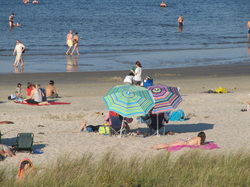 Crane Beach in Ipswich! Monday, October 10, 2011
Today I went on the water tour of the canals in Lowell given by the Lowell National Historic Park. It was interesting to see how the locks work and the ranger explained how the drops in the water in this area (37 feet) create the "water rush" and force that made the water wheels turn underneath the factories to create the power/movement that ran the machines. Unfortunately, the water levels were too high for us to go out on the Merrimack River.
I also saw a movie at the park about the history of Lowell that went from farmland to industrial center in the early 19th Century to "blight" in the early to mid 20th Century to the revitalization beginning in the 1970s that it enjoys today. This is a very busy community and the "come back" has been very successful! Part of that revitalization has been the transformation of many of the mill and factory buildings into art studios, condominiums, and other things as well. In fact, the condo where I live was once a mill. That explains the 20+ foot ceilings and gigantic windows!
This was such a BEAUTIFUL fall day -- sunny and 80 degrees -- the kind of day that you want to put in a can and pull it out in February! I HAD to take advantage of it so I decided to drive to Ipswich, a small town on the coast of Massachusetts. Thanks to Monica, my navigator, I drove "over the river and through the woods." It was sooooo lovely :) Some of the roads were canopied with colorful trees and lined with ponds, cottages, stately homes, and mom and pop businesses like the Clam Box. It was nothing less than picturesque. Now this is what I think of when imagining New England in the fall!
I arrived at the Ipswich visitor center after surviving the intersection from hell and driving over Choate Bridge, c. 1764, claimed to be the oldest bridge in America. I knew the museum was closed today but since it was such a beautiful day, I wanted to go anyway just to check things out and see what the town was like.
Ipswich was settled in 1625 and according to the records I've seen on line, Thomas Dorman was a resident there in 1634 - 1636. My mother was a Dorman and her ancestor, John Dorman arrived in the colonies sometime before he married in Somerset, Maryland in 1638. He had a brother named Thomas. Was this Thomas in Ipswich him? The very helpful lady at the visitor center (what was her name???) sent me to the library, which was closed because it's Columbus Day. But I'll be back! She also told me that the Ipswich Museum does in fact have examples of lace made there centuries ago. Lace making was a thriving industry in Ipswich at one time. I want to see that stuff!
Ipswich has many seemingly well preserved homes from the 17th and 18th Centuries. Driving around these homes have oval plaques on the front of them with the date and (must be) surname of a family -- perhaps the first owner. It was pretty amazing how many there are. They all seem well kept. I'm just amazed that so many are still standing! When I come back to go to the museum, there are two, the 1670 Whipple House and 1800 Heard House, that I will tour. Can't wait!
It was such a gorgeous day, I HAD to go to the beach. I had a map, and decided to try this one on my own, without Monica's help. To my surprise, shock, and amazement, I got there without making any wrong turns. Being from the Midwest, I knew there would be some culture shock. I thought that would be about the people. The people are great, but the roads are HORRID! It's like someone threw a plate of spaghetti down on a map and made roads out of it! No Kidding! They make no sense, they aren't in straight lines, there are many one-way streets, they wind this way and than, they change names two or three times from one end to the other, and they all seem like one of those mazes we use to do in magazines on road trips when we were kids. So, saying I made it to the beach without Monica is saying something!
Crane Beach was lovely and I'm so glad I decided to go. There were many families there soaking what will probably be the last day of Indian Summer. There were kites flying, Frisbee games, people riding horses along the beach, a few boats, and a lovely view. I brought a blanket and a book, so I read and enjoyed the view -- I just took it all in. I did venture down to stick my feet in the water -- I had to do that!!! It was a bit chilly, but what a nice feeling to sink into the sand and feel the water rolling over my feet. :) It was a great day and one to be remembered!
 Bales of cotton waiting to be spun Sunday, October 9, 2011Today, Pam and I went to Slater Mill in Rhode Island. This is the home of the first power mill, spinning operation, in the United States. Although there were plenty of powered mills in England, there weren't any in the U.S. until Samuel Slater, at age 21, immigrated to the U.S. and brought his knowledge and experience with him to build the equipment and use the water for power. Thus, in the late 18th Century the industrial revolution that would change everything began. Slater Mill is also the story of immigration, child labor, women's rights, artisans, cotton and the development of labor. Pam gave a talk about the history of the textile industry in New England. She also brought a few quilts to show period fabrics and quilt patterns. This day was also the day that quilt and textile art guilds meet at Slater Mill. They brought their wares, and many were practicing their craft. That was fun and I even learned to spin cotton -- well sort of using very simple tools. But there were spinning wheels going! We looked around in the mill a little bit, but didn’t have a whole lot of time. We did get to look at quite a bit of machinery, although it wasn't operating, athough didn't get to take a formal tour. I’ll have to go back if time permits!
After leaving the mill, we drove to the home of Doug Stark to review his collection of political memorabilia including buttons, ribbons, and framed handkerchiefs. What a nice collection he had! Some of the framed pieces will be hung and some ribbons will be used in the show cases that are part of the C&C exhibit. Pam and I took photos of his framed handkerchiefs and some of the ribbons. We'll review them and decide what to use in context with the other objects in the show. In December, Pamela will return and collect the items that will be used during the exhibition. Click here for my photo gallery
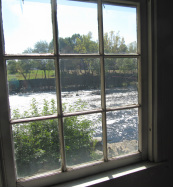 Saturday, October 8, 2011
Today I continued working with the exhibit workbook. I scanned images of each quilt, cropped them, and began creating a power point presentation for the exhibit. Each page included an image of the quilt, the quilt name, and year or range of years represented. There is a text area where I will be able to add more information about the quilt. I think this is the beginning of my catalogue. But for now, it is a great electronic working document where I can keep notes, and always have an image at hand. I also printed a contact sheet of all the quilts we have images for. There are a handful of quilts we have no images for. I look back on this day and think about how long it took to do this, but it doesn't sound like much!
 Teddy Roosevelt Handkerchief Quilt Friday, October 7, 2011
Today I organized the exhibit workbook and worked on Excel spread sheets Pam had started for the C & C exhibit. This gave us a snap shot view of the quilts, and the stage where they currently are – received, paperwork sent, paperwork needs to be sent, terms still being negotiated, or quilts still being sought after. This is a working document and will be updated as information is available and as conditions change. I organized the document first in categories of the status of the quilt; a second document was created which put the quilts in date order so we could see where the gaps of time are and where we need additional quilts to fill in.
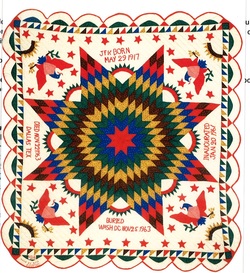 The Lone Star Kennedy Memorial Quilt Thursday, October 6, 2011
Pam introduced me to the Campaigns and Commemoratives: Quilts for Presidents Exhibition that opens in January. We reviewed the quilts, and sorted which ones still need to be tracked down, and the status (paperwork received, still negotiating details, etc.) of the others slated to be in the show. Pam has a notebook where she has kept all her notes, images, emails, etc. for each quilt she is including in the show. She explained to me how this evolves into a legal document because of the loan agreements, receipt of the quilt, condition reports, etc.
Pam set me loose a little bit and I was able to track down a website for Charlotte Christainsen Bass – her quilt The Grand Old Party is one we would like to have for the show. Pam wants to represent a balance of political viewpoints, but she said she is having trouble finding anything that represents Republicans.
We spent some time in the museum library. WOW WOW WOW!!!! They have almost 4000 books related to quilting and textiles. Some are duplicates that are loaned out to museum members. They have a database in house of their book collection that they would like to get on line.
Pam and I met with Connie to discuss the Website. I told her they need to set short term and long term goals for their site. I asked about the possibility of getting a grant to have the site completely redesigned using current technology and bringing the “look” up to date. I also suggested they partner with the University of Massachusetts here in Lowell and see if she can plant the seeds for an on-going relationship with them for technology and graphic design assistance. Connie has a contact with UMass through the husband of a board member and she will pursue this idea. We discussed what changes they wanted for their site in the short term. Maureen Smith, the person who keeps their current site up-to-date is out of town until next week, so our discussion was a bit limited.
 The New England Quilt Museum Wednesday, October 5, 2011
I found the museum! It's only about two blocks from my new home away from home. On the way, I passed the Lowell National Park Visitor Center. When I arrived I joined an already-in-progress staff meeting with Director Connie Barlow, Curator Pamela Weeks, Collections Manager Laura Lane, Community Outreach Coordinator Rhoda Galpern, Office Manager Joan Ciolino, and Shop Manager Quita Schillhammer. Connie was very welcoming and graciously thanked me for the gift of 300 hours of my time! I am very appreciative of this wonderful opportunity and can't wait to get into the thick of things :)
Pam gave me an abbreviated tour of the museum and filled me in about who’s who, and things that were discussed at the staff meeting. Then we went to get coffee and get acquainted. Later, I talked with Quita about her hopes for an on-line shop presence, and Polly, one of the many dedicated volunteers, about her comfort level of maintaining the shop page on the Web site. Mostly today was getting acquainted with the staff and the museum.
One thing about NEQM that is not what I expected is their large shop. When you enter the museum from the front door, you are in the shop. They have quite a variety of items to purchase: antique sewing tools, quilt kits, antique and new quilts, small journal-sized art quilts, fabric, thread, jewelry, jackets, blankets with star designs, books, greeting cards, tote bags, and an array of consignment items including old (antique maybe?) fabric sample cards from the manufacturer. The list goes on and on! It's not the typical museum shop since you can actually purchase sewing supplies there!
The museum gallery is upstairs. Currently there is a show called Maine's Quilt Heritage. This weekend it will come down, and the next show, Patience to Raise the Sun: Art Quilts from Haiti & their Power to Change Women's Lives will go up. So we will be working Sunday, Monday, Tuesday and maybe Wednesday changing over the exhibition. A lot of work, but a great experience for me!
 The Lowell Girls at the Mill Monday, October 3, 2011Today I arrived in Lowell. It was raining and nearly dark, but I made it! It's been three days of driving and over 1400 miles. When I was in junior high, we lived for a brief two years near White Plains, New York. Other than brief trips to Boston and NYC, I've never spent any length of time in this part of the country. I'm excited to say the least!
I've always though it would be wonderful to see fall in New England and now here I am. The leaves are beginning to turn, but the colors haven't peaked yet.
While I am here working at the New England Quilt Museum, I have a room with Mariette and Jim Auger in their condo. It's so nice because it's within walking distance of the museum. I have access to a parking garage for a small fee which I didn't appreciate until I arrived. Unlike home, parking space is prime property. Those that have a space in the parking lot of the condominium purchased them for $10,000 - $20,000. YIKES!
Mariette is an incredible cook and she loves it, so let's just say we've worked out an "arrangement." By the way she's French, so think about what her cooking must be like. Whatever you just thought of, her cooking is better than that! What a treat. Besides which Mariette and Jim are nice, easy to get along with and they treat me really well. I think this is going to work out very well. My room is spacious, and has two great big windows that overlook the canal. There is no extra storage in these condos -- no locked storage space in the basement or anything like that. So, you can imagine how precious space is. I have stored my suitcase in my car because there is no where else to put it! Pam (the curator) will not be in the museum tomorrow so that means I will have the day to settle in and get organized. I'm so happy to be here and I am looking forward to the adventure. Not only do I have the opportunity to work at a quilt museum with Connie Barlow and Pamela Weeks, Lowell is such an important area in the history of textiles and the industrial revolution. And of course, there are many other places in the area that were key as well. I have a long list of places I want to visit while I'm here. There are so many that I'm afraid I will run out of time. That's the kind of problem I like to have!
|


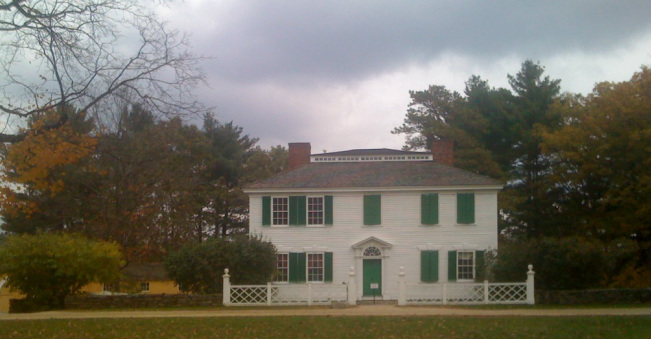























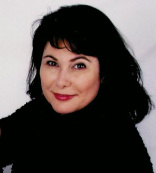
 RSS Feed
RSS Feed